Grow a Kitchen Garden in 16 Square Feet
http://decor-ideas.org 03/29/2014 22:22 Decor Ideas
With just a patch of soil and sunlight, you can create a mini kitchen garden. It won’t feed your family for the summer, but it can make your meals more interesting, and perhaps get kids interested in growing food or at least help them understand where it comes from. The trick is to choose the right crops. Varieties should be compact enough not to outgrow the space and should be productive over a season — so you are not eagerly waiting for weeks for a harvest that lasts minutes.
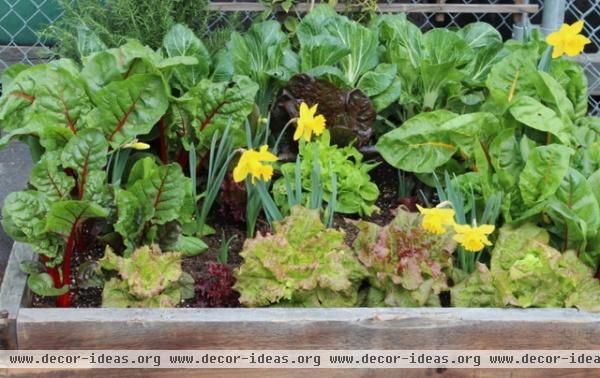
If you don’t have space in the ground, you can grow vegetables in a convenient raised bed or planting box. This one is 4 feet by 4 feet, constructed of two 2-by-6s on each side. Fill the planter with a commercial soil mix; if you plant in the ground, improve the soil by adding a layer of several inches of organic matter, and work it in to a depth of 8 to 10 inches.
Make sure the spot gets sun for a good part of the day. Choose smallish varieties. There are many ways to go. Here in front is a row of leaf lettuces. Just behind, there’s a scattering of beets plus a few daffodils. In back there’s a row of chard and a single rosemary shrub. Make sure that the plants you select have compatible demands for water, light and feeding.
Salad Greens
For the planting’s front row, choose low-growing leaf lettuce varieties or curly endive, which has an appealing bitterness. These are greens that you can keep cutting rather than waiting for them to form mature heads. Most leaf lettuces do best in cool weather. As summer moves in, you can replace them with chard, herbs or other more heat-tolerant types.
When and how to plant: Sow seeds or set out seedlings starting in early spring. For a fall crop, plant when the weather starts to cool. Sow seeds in rows about ⅛ to ¼ inch deep or by broadcasting and covering them with a thin layer of soil. After the seeds sprout, thin the seedlings to about 4 to 8 inches apart. Space nursery seedlings the same distance apart.
More about starting a garden with seeds
Days to maturity: 65 to 90
Light requirement: Full sun or partial shade in hotter climates; too much heat makes the plants bolt and go to seed.
Water requirement: Keep the soil moist.
Favorite varieties: There are many leaf lettuces, including colorful types, such as Oak Leaf, Red Sails and Red Salad Bowl
Planting and care: Keep the soil moist constantly. Watch for aphids; wash them off with a hose. Keep an eye out for hungry birds and rabbits; protect the plants with netting or another method.
Harvest: Cut individual leaves as needed.
How to Grow Lettuce
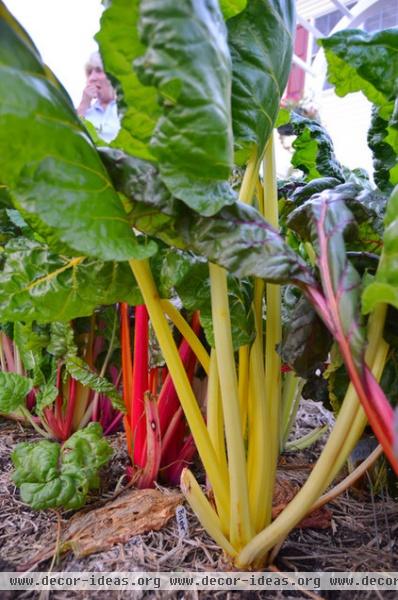
Chard
Swiss chard is one of the easiest vegetables to grow and has a long season. You can wait for the plants to develop crunchy stems or harvest the tender, young leaves to use as greens or to braise.
When and how to plant: Sow seeds or set out seedlings in early spring. For a fall crop, sow them in late summer and fall. Sow seeds ½ inch deep, 2 inches apart; thin seedlings to about a foot apart. Space nursery seedlings accordingly.
Days to maturity: 60
Light requirement: Full sun, or partial shade in hot climates
Water requirement: Keep the soil fairly moist.
Favorite varieties: Fordhook Giant is a classic, although it tends to get large. Bright Lights and Rainbow add color.
Care: Stay on top of weeds; there are no particular pest problems.
Harvest: Start harvesting tender, young leaves as small as several inches tall. After a couple of months, you can pick mature leaves individually from the outside.
How to Grow Chard
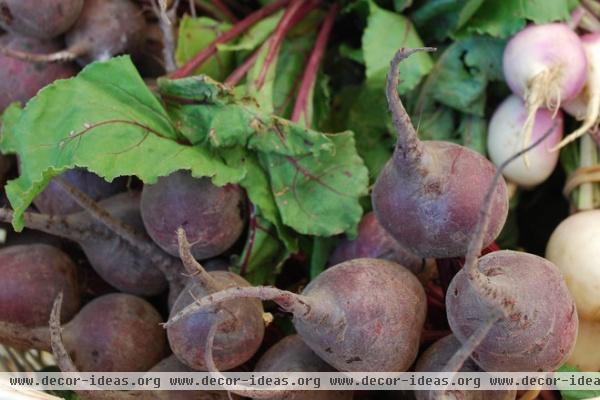
Beets
Beets are among the most space-efficient crops — with tasty tops and, of course, the familiar roots. The leaves are pretty, and the variety of beet colors can be striking. Look for smaller types.
When and how to plant: Sow seeds in early spring or early fall. Space them an inch apart and cover with ¼ inch of soil. Make sure the soil is free of rocks.
Days to maturity: 45 to 60
Light requirement: Full sun or partial shade
Water requirement: Water regularly.
Favorite varieties: If you want unusual colors, consider Chioggia, Golden and Yellow Detroit.
Care: Thin seedlings to about 2 inches apart. The thinnings, both tops and bottoms, are edible.
Harvest: Pull roots when they’re 1 to 3 inches thick — smaller ones are more tender. Eat the tops while tender; use for salad greens and braising.
How to Grow Beets
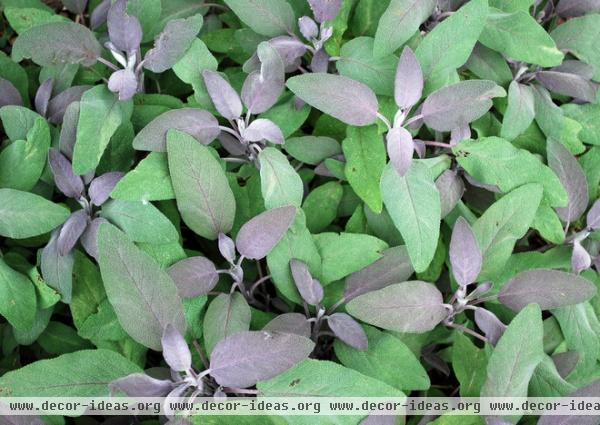
Culinary Sage
Add a couple of herbs of your choice. Choose what you like and will use for cooking, such as basil, marjoram and parsley. Shown here is culinary sage (there are many other nonculinary types), which can last several years with the right conditions.
When and how to plant: Set out nursery seedlings when the weather warms in spring and summer.
Light requirement: Full sun, or partial shade in hot climates
Water requirement: Moderate.
Care: Control the size and bushiness with regular pinching. Make sure the soil doesn’t become soggy.
Harvest: Pick off leaves and flowers as needed; generally it’s best to wait until the plants are 6 inches tall — unless you want to just snip a few leaves.
Grow Your Own Culinary Sage | Learn about growing other herbs
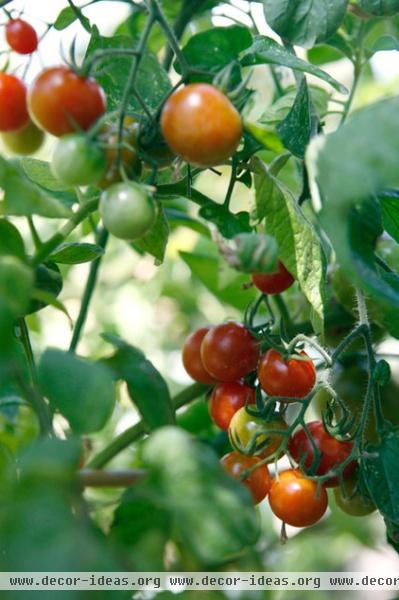
Backdrop Edibles
At the back of your planting, provide a trellis or netting or another support for climbing or vining plants. Less rambunctious vining peas or beans will work, but don’t expect much production from a small space. It’s fun to grow a tomato there, although space constraints mean the plant will need extra attention. Shown here is ‘Early Girl’, an indeterminate type, which keeps growing up rather than spreading out. One plant is plenty. Be prepared to tie and prune it to fit the space you have.
How to Grow Tomatoes
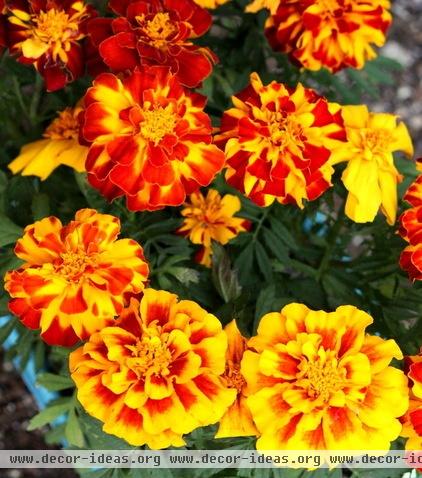
Marigolds for a Finishing Touch
A few summer annuals add sparks of color. Marigold is a fine choice — a traditional vegetable garden companion considered to have beneficial powers. Look for compact types.
When and how to plant: Set out nursery seedlings when the weather warms up in spring.
Light requirement: Full sun
Water requirement: Moderate; marigold isn’t fussy.
Favorite varieties: Shown here is Safari Bolero, which grows to 14 inches tall. Many varieties are smaller.
Care: Pinch off the flowers as they start to dry.
More: 10 Expert Tips for Growing Edibles in Containers
Related Articles Recommended












